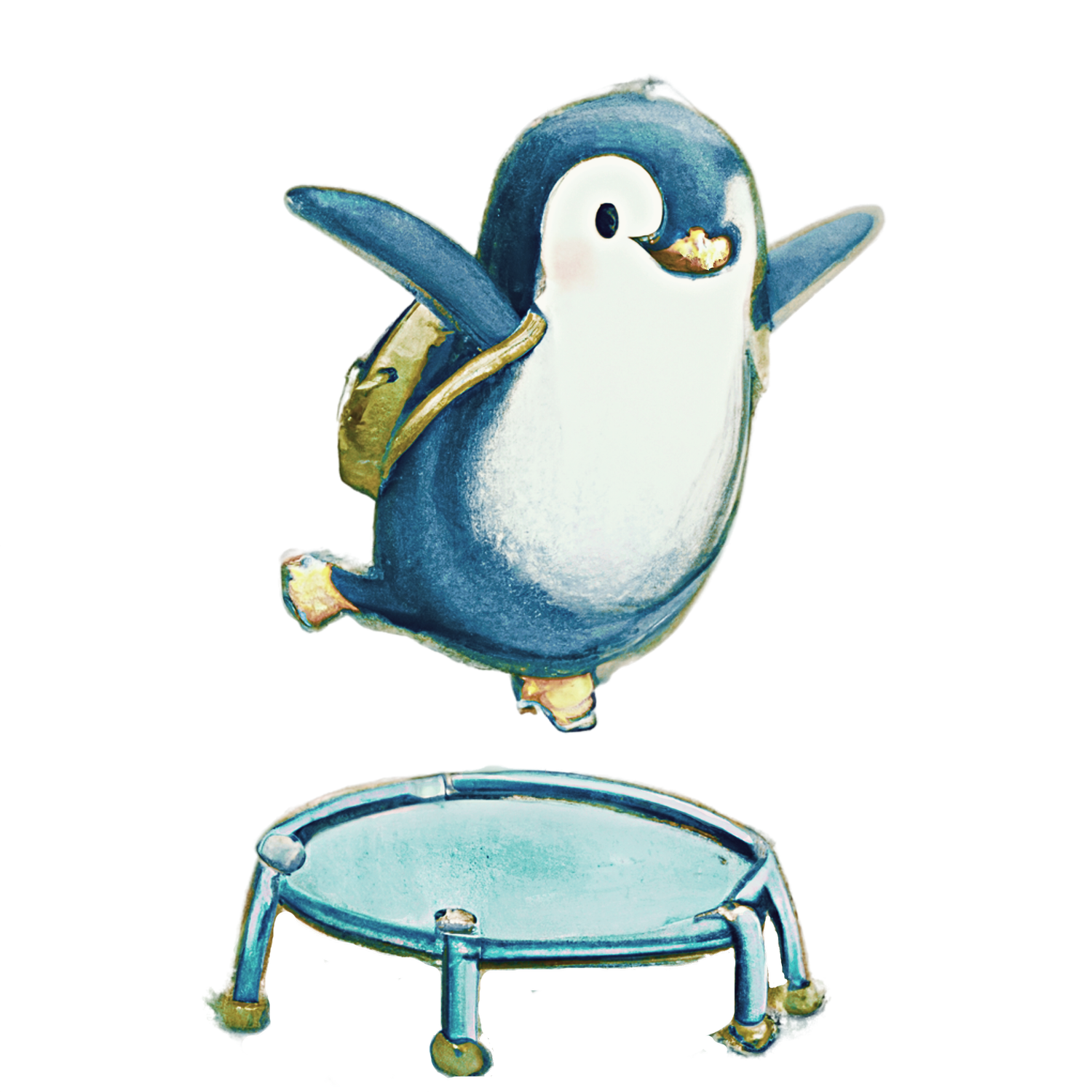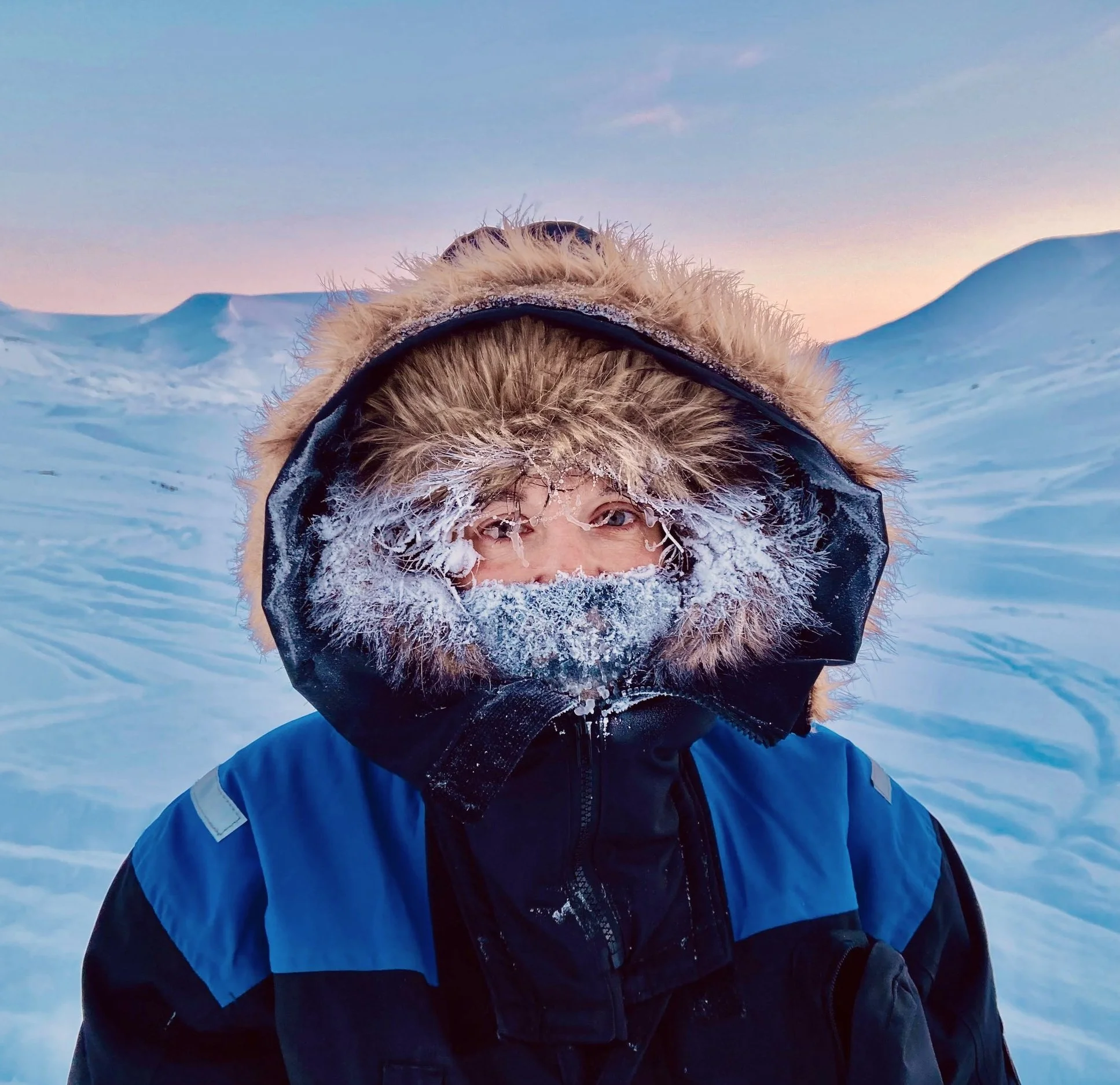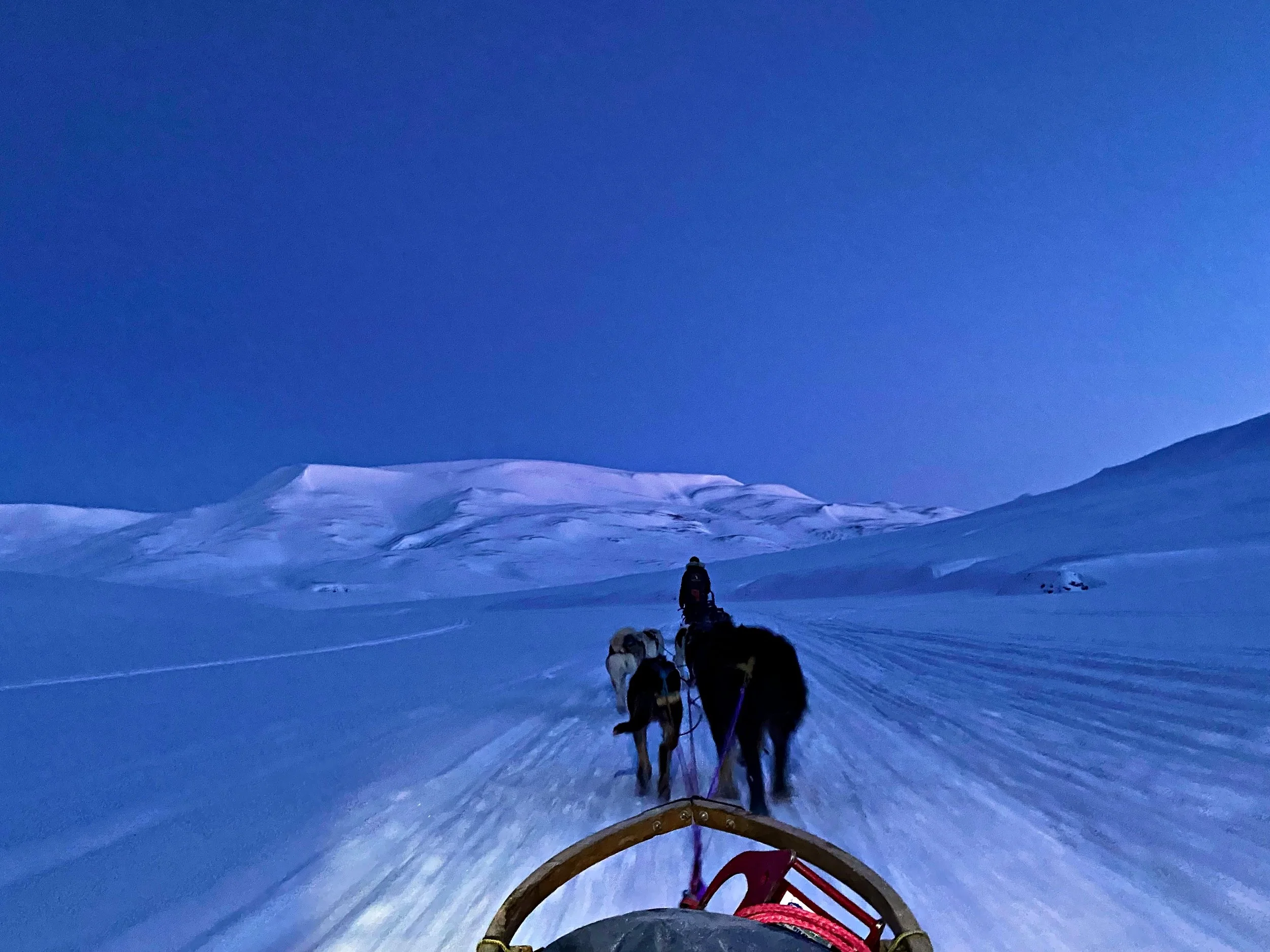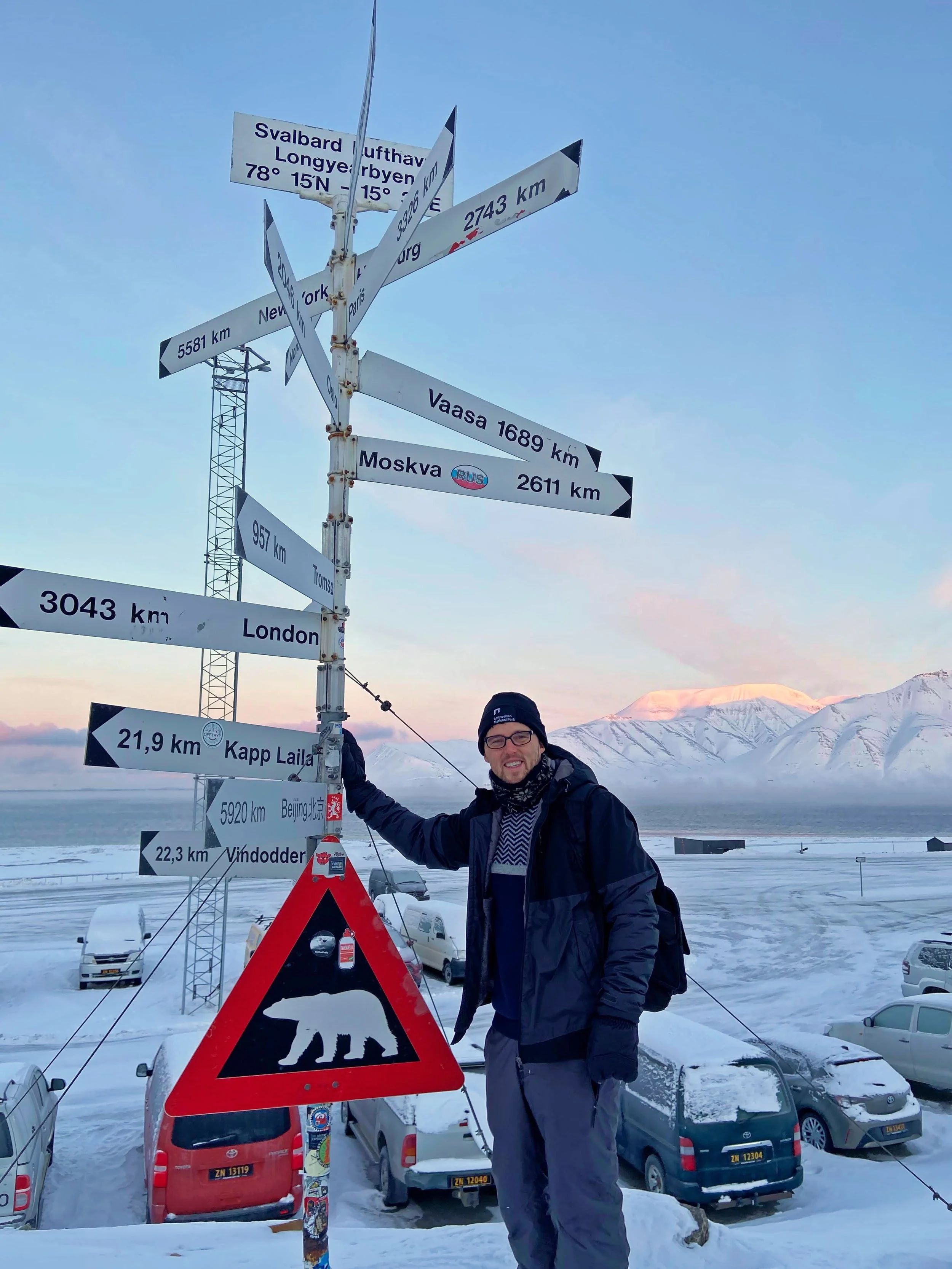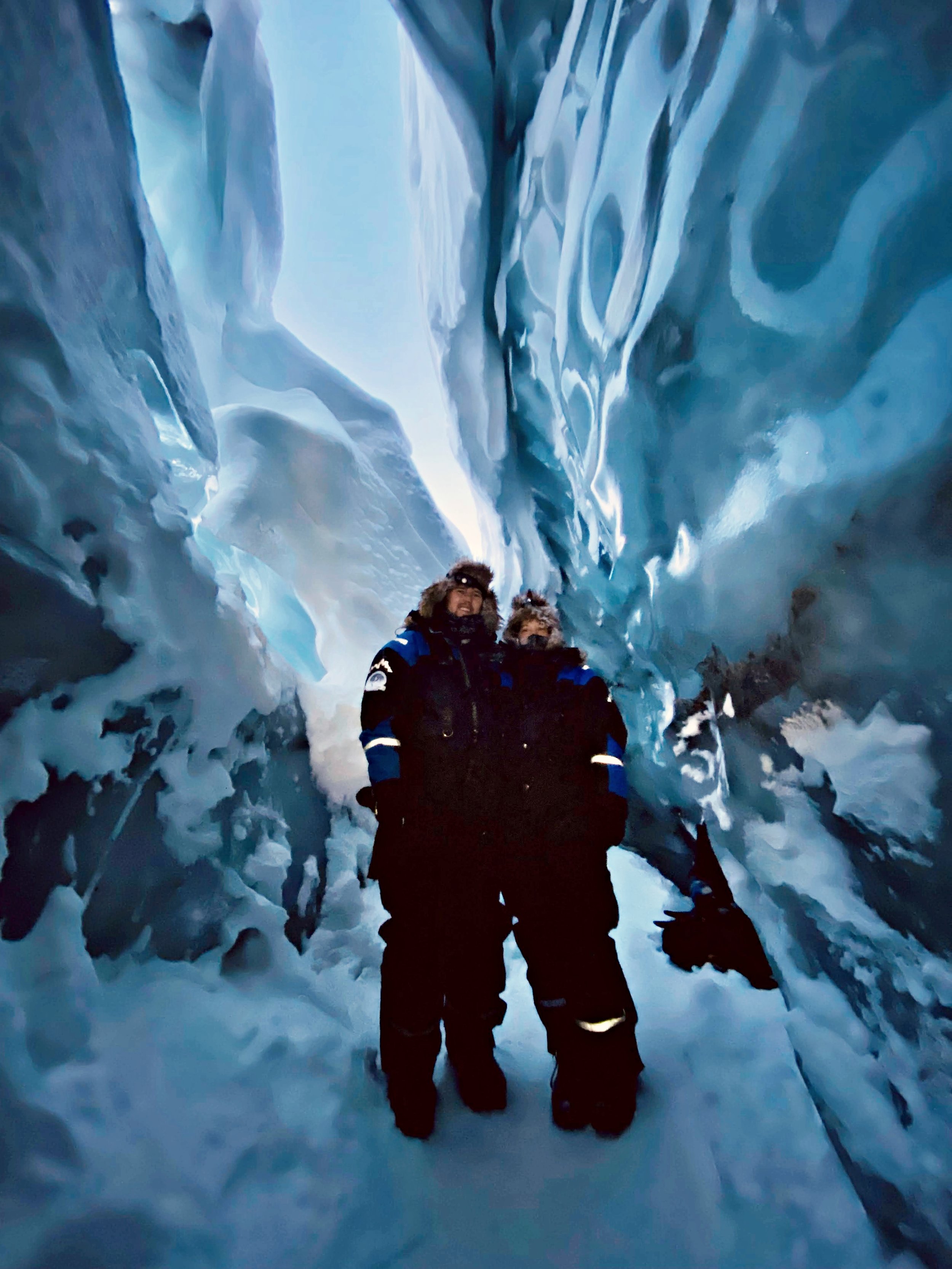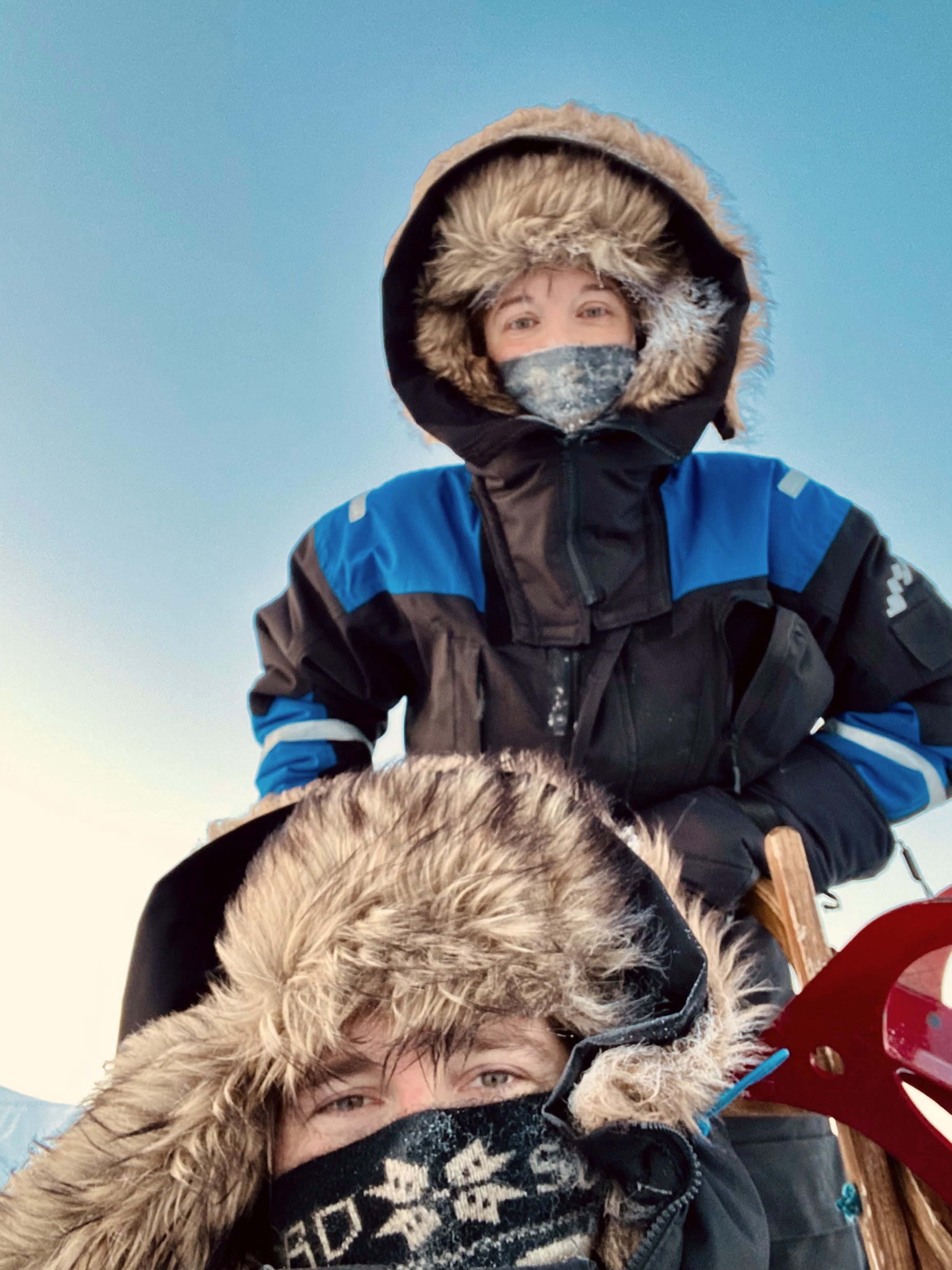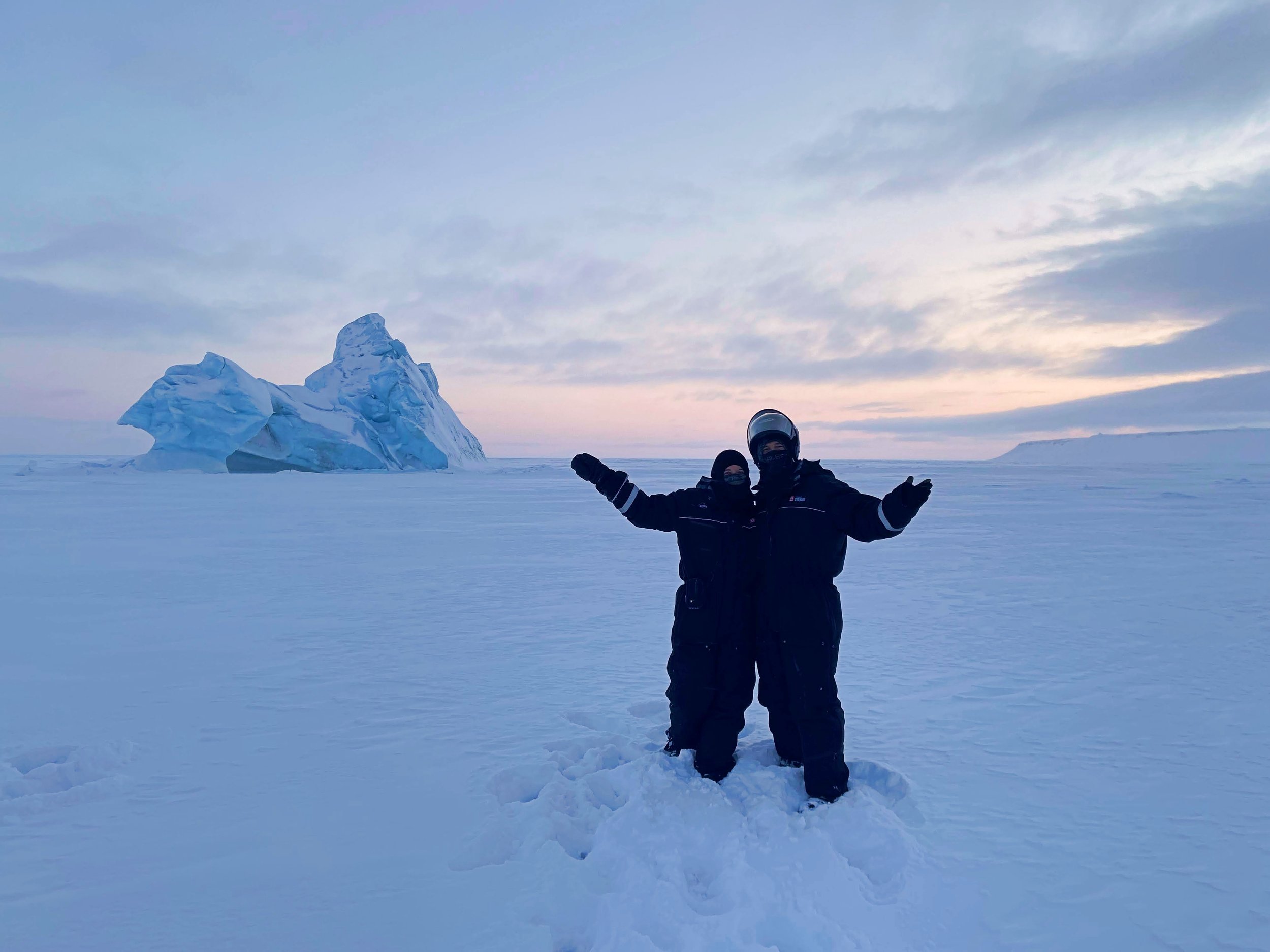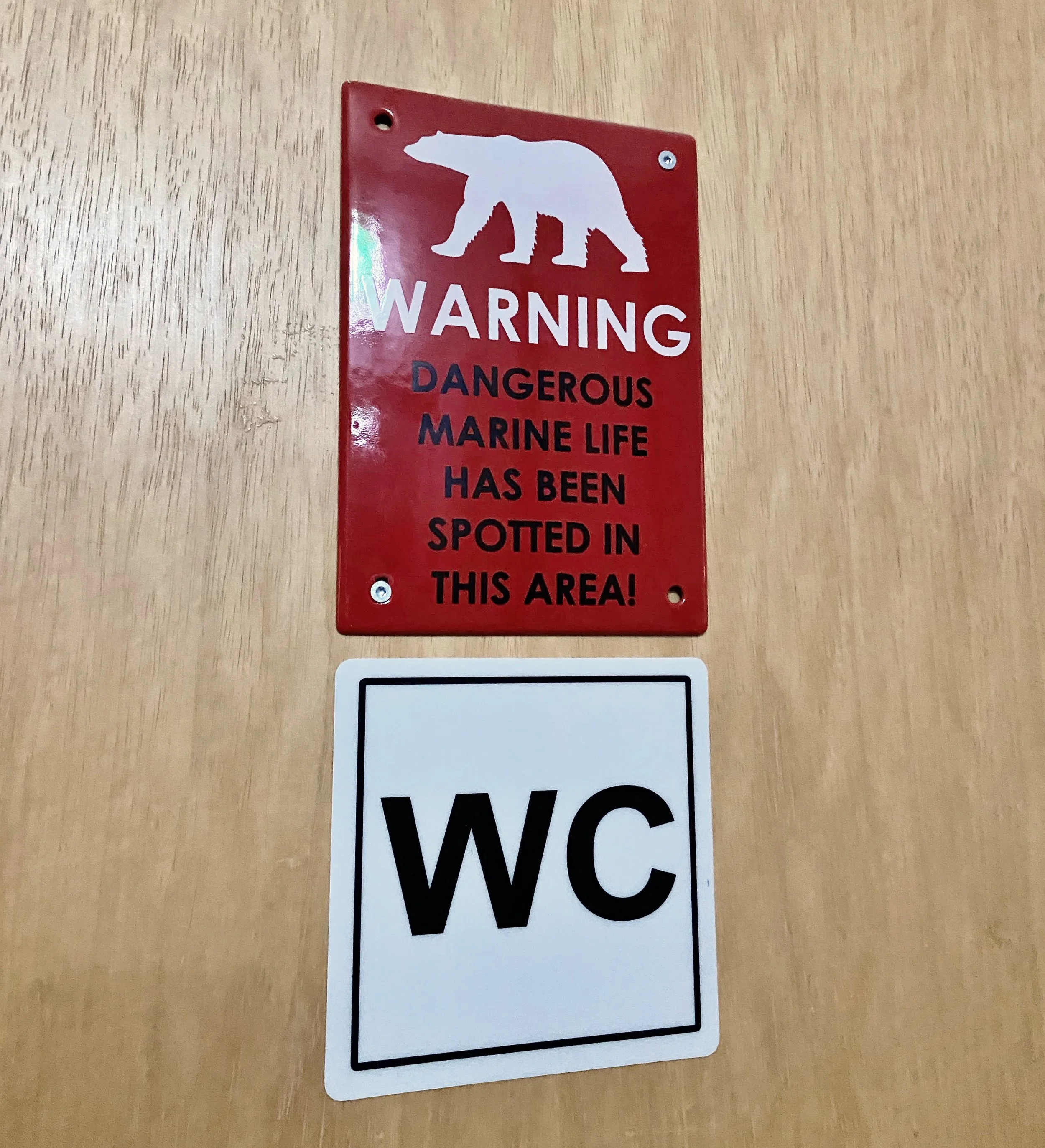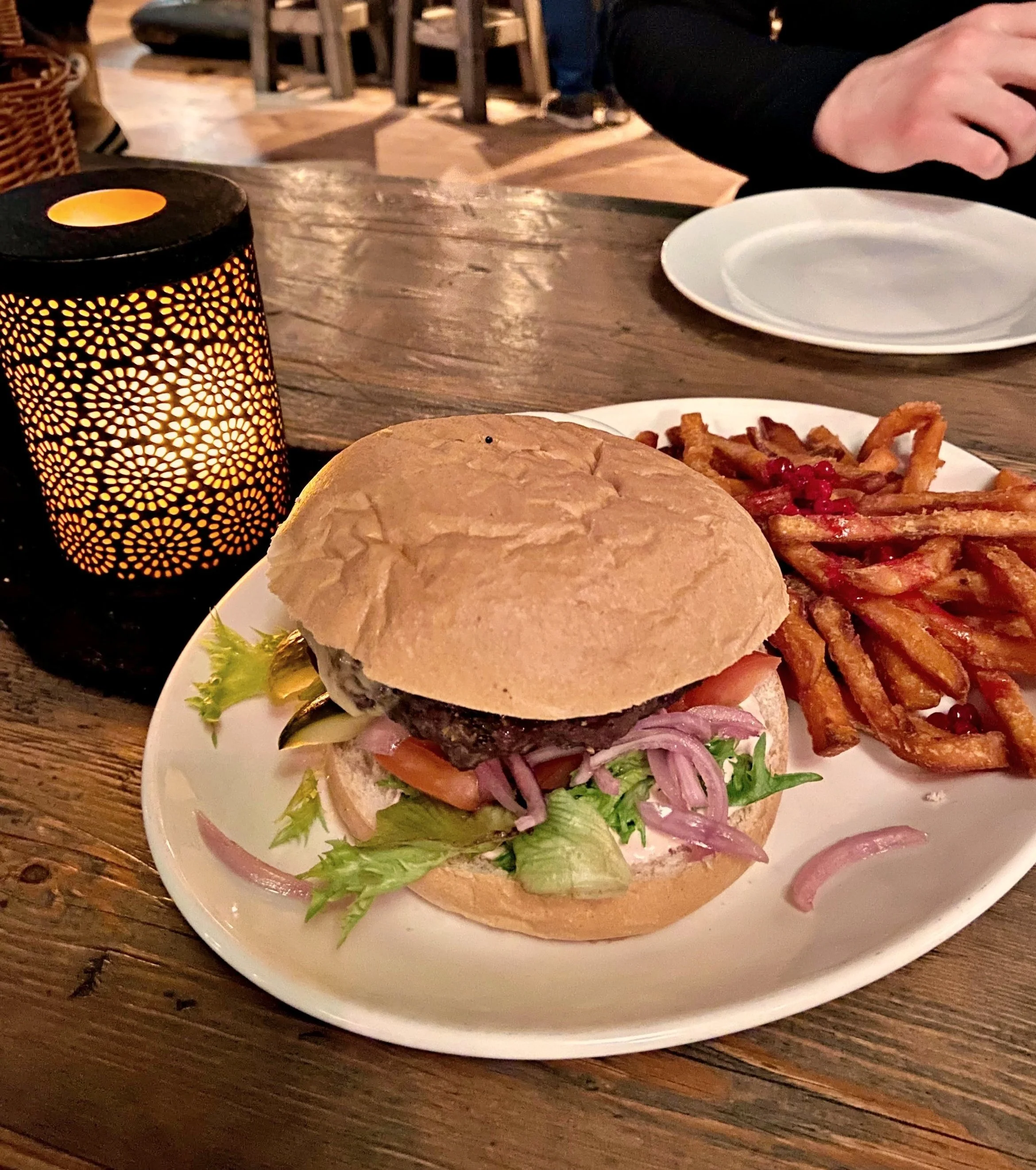Svalbard & Jan Mayen: Full Travel Guide
Understand the true meaning of rugged wildnerness at the edge of the world
The East Coast, Svalbard and Jan Mayen
Svalbard had been on our bucket list for a long time. And we finally took the leap… with a little help from a Black Friday offer on flights!
Remote… Freezing… Empty… Dark… Everyone kept asking us why on earth we decided to go there.
Well, because it’s the northernmost place you can go without an expedition, which means flights are actually affordable.
Yep, the northernmost, so close to the North Pole… How could we NOT want to go there? And in the heart of the winter, of course!
Plan your Arctic adventure
Find a cozy place to stay and things to do in Svalbard.
🧳 Field Notes
When we went: February, the heart of the polar night turning back toward light — still dark, still frozen, but magical blue/purple light and possibility to see the northern lights.
Where we stayed: At the cheapest accommodation in town (hostel), Gjestehuset 102.
How we got around: Organized tours — snowmobile expeditions through the valleys, a visit to the ice caves, and local guiding from Hurtigruten Svalbard. Walking alone outside town isn’t allowed without a rifle escort (yes, really).
Highlights: Experiencing real Arctic wilderness on “true” expeditions, learning about life in the world’s northernmost town, and realizing how Svalbard mixes research stations, wilderness, and raw survival.
Mistakes we made: Thinking we knew what the true Arctic was.
🗓️ When to see the northern lights in Svalbard
The aurora season in Svalbard runs from late September to early April, with the best viewing usually between December and February, when nights are longest and skies clearest.
On a calm night, you can often see the lights right from Longyear — though it’s always better a little outside the glow of streetlights.For photo settings, gear advice, and the best Northern Lights destinations across Scandinavia, check out our full 👉 Northern Lights Hub.
Let’s be real : hiking across Arctic tundra or chasing reindeer through a snowstorm isn’t exactly risk-free — we actually had a snowmobile wreck ourselves, but more on that later. So do yourself (and your limbs) a favor: get solid travel insurance. Heymondo’s got your back with packages that actually cover outdoor adventures, and if you book through us, you’ll score a 5% discount (sometimes even 15% during promo bursts). It’s like wrapping yourself in bubble wrap… but cooler.
Where is Svalbard and Jan Mayen? Or is it Spitsbergen?
While we had been dreaming about traveling to Svalbard for decades, we quickly realized that most people around us had no idea where it was. So, here is a brief geography lesson just for you!
Svalbard and Jan Mayen are actually two separate territories, but they’re often mentioned together due to their geographical proximity.
Svalbard is an archipelago located in the Arctic Ocean, situated about halfway between mainland Norway and the North Pole. The largest island in the Svalbard archipelago is Spitsbergen.
Jan Mayen, on the other hand, is a separate volcanic island located in the Arctic Ocean, northeast of Iceland. It’s much smaller than Svalbard.
Spitsbergen is the largest island in the Svalbard archipelago and is often used interchangeably with Svalbard, but it's important to note that Svalbard encompasses several islands, with Spitsbergen being the largest among them.
That being clarified, we went to Spitsbergen! We flew to Oslo with Vueling, and then to Longyear with Norwegian.
You’d better not die!
Svalbard is full of hazards, but beware: you can’t die there! Death has been banned since the 1950s. If someone is close to dying, they have to be flown to the mainland, as the permafrost prevents buried bodies from properly decomposing.
Here is Eli trying not to die!
Tourism or not tourism?
Tourism is not inherently sustainable.
So, obviously, arctic tourism raises controversy.
On the one hand, we need to protect and preserve Arctic regions, so bringing visitors seems counterproductive.
On the other hand, it’s hard to respect, wonder and care for a place if you only see it in magazines.
Mushing at 3pm with a head lamp
Of course, Arctic travel should be planned and managed carefully. Visitors always need to be “educated” when they go somewhere, and tourist organizations must work hand-in-hand with locals.
But the truth is, polar regions will never attract mass tourism. Most people are simply not interested. And most visitors to the Arctic are respectful and aware of the environmental threats.
So, while Arctic regions are facing challenges, tourism is far from being the biggest one.
At Penguin Trampoline, we don’t pretend to have all the answers or a magic wand, but we can only base our point of view on experience and interactions with locals wherever we go.
One of our guides, Nicolas, underlined the necessity to bring people to polar regions, so they can come back as ambassadors and raise awareness.
Polar bears in Svalbard
Svalbard is famous for its polar bears, but unfortunately — or fortunately? —, we didn’t see any. Sightings are rare around Longyearbyen, so you’d have to go on a multi-day snowmobile trip, or a summer cruise, to have better chances to spot bears.
Svalbard provides an important habitat for polar bears, offering sea ice platforms from which they hunt seals, their primary prey.
Track a polar bear
Are you as obsessed by polar bears as I am? You can track a real polar bear as it roams the Arctic with Fahlo’s Ice Tracker bracelet. They partner with Polar Bears International, which we interviewed in another article. Get 20%!
The polar bear population in Svalbard faces challenges due to climate change, which affects the extent and stability of sea ice. As the ice melts, polar bears have to travel longer distances to find food, making it a concern for their conservation.
To protect both humans and polar bears, strict regulations are in place in Svalbard. When traveling outside settlements, it’s mandatory to carry appropriate equipment, such as firearms, to defend against polar bear encounters.
And if you don’t know how to use one, you’ll need to hire a guide who does.
The main settlement, Longyearbyen, is surrounded by signs marking the polar bear zone limits, and it’s perfectly safe to walk around town within these limits.
The wildest proposal
Jake proposed right at the polar bear limit, North of Longyearbyen, after waiting the whole week for the Northern Lights to show up (unsuccessfully).
Although I couldn’t imagine a better proposal for the polar bear addict that I am (Eli writing here), it was -36 ºC and I couldn’t take off my second layer gloves for the pic — the only one we took before we had to rush inside!
We later realized it was the wrong hand. High five!
Longyearbyen: the town in the middle of nowhere
After flying over the Arctic Ocean and frozen land for hours, landing in Longyearbyen — or Longyear, to sound local — seems unreal.
This settlement of about 2400 inhabitants from 53 countries is surprisingly modern and well-equipped.
Longyearbyen main shopping street
You’ll find restaurants, a large grocery store, a shopping center, a school, a sport center, a hospital, a church, a museum, a university and a post office, among other facilities. And free roaming reindeer.
The town was founded by an American, John Munro Longyear, in 1906, as a coal mining settlement.
However, in recent years, there has been a shift towards a more diverse economy, including research, tourism, and education.
Due to its strategic location in the Arctic and the presence of the University Centre in Svalbard, Longyearbyen serves as a hub for Arctic research. Scientists from around the world come to study the unique environmental conditions and ecosystems, for example the organization Polar Bears International (Eli is a member).
Did you know?
Technically, anyone can move to Svalbard as the archipelago is an entirely visa-free zone. You don’t need any residence permit to live in Svalbard, as long as you can support yourself.
Anyone interested?
When to visit Svalbard?
Each season is magical and has its own charm and perks.
Keep in mind that Svalbard's weather can be unpredictable. Regardless of when you visit, it's crucial to be well-prepared for the harsh Arctic environment, with appropriate clothing and gear.
Also, consider the type of activities you want to engage in when planning your visit to Svalbard. Check the best tours season by season here!
It all comes down to your preferences, budget and availability, but here’s a brief guide.
Summer (late April to early September)
During the summer months, Svalbard experiences the Midnight Sun, with continuous daylight from late April to late August. This period is ideal for activities like hiking, bird watching, and experiencing the unique Arctic flora.
Summer is also a good time for wildlife observation, including birds, seals, and whales. Polar bears can be spotted, especially on the sea ice. Several cruises are available.
The downside is that prices are much higher, as it’s high season.
Autumn (late September to November)
As the nights gradually return, autumn becomes an excellent time to witness the Northern Lights (Aurora Borealis), with “warmer” temperatures than in winter. The dark skies and latitude provide optimal conditions for this natural light display, if the weather allows.
Check out our article on Northern Lights for Dummies for the best tips!
Towards the end of autumn, Svalbard starts transitioning into winter activities like dog sledding and snowmobiling.
Winter (December to March)
Svalbard experiences the Polar Night, or Blue Season (great marketing!), a period of continuous darkness, from late November to late January. This is another opportunity to witness the Northern Lights. But temperatures are much colder, and it’s harder to stay outside for long.
Now, despite the popular belief that the Arctic is just dark and gloomy in winter, I can ensure you that it’s very colorful. Imagine an eerie blue hue, and a never ending purple-pink dusk and dawn. Add the snow reflection and the Northern Lights, and you’ll get the most amazing painting!
Winter is the season for activities such as dog sledding, snowmobiling, snowshoeing and cross-country skiing. It's also a unique time for ice cave exploration and photography.
The pristine Arctic landscapes covered in snow offer a quiet, impossibly serene atmosphere.
For us, this is the best season to experience the true Arctic, while benefiting from lower prices and accommodations and flights.
Just know that it’s really, really cold, and that there’s nowhere to warm up when you’re out there. Take it from two people who the cold never bothered, anyway!
Remember to pack extra batteries for your phones and cameras, because they won’t last long. That is, if you manage to take off your outer glove to take a pic!
On our way to Barenstburg in February - It’s noon! (no filter)
Spring (April to early May)
With the arrival of spring, the daylight gradually returns, and the snow begins to melt. It's a transitional period with a mix of winter and spring activities.
Spring is a good time to observe Arctic wildlife, including seals, birds, and polar bears.
In Longyear, locals celebrate the return of the sun.
What to do in Svalbard
Find the adventure of lifetime with these tours and expeditions
As mentioned, you can’t do much without a guide or a rifle, and it would be a pity to stick to Longyear alone.
The best way to really experience Svalbard and Jan Mayen is to book excursions. Of course, these are not cheap, so chose them wisely. Anyway, after 3 or 4, your body will beg you for a rest!
Speaking of which, these excursions are inherently hazardous due to the terrain and remoteness. Therefore, book a good travel insurance covering the activities you want to do. Heymondo offers comprehensive packages including outdoor activities, and you’ll get an exclusive 5% discount (up to 15% when they have seasonal promotions) if you book it through us.
Below are a few recommendations - Make sure to book in advance, as space is limited and groups book well ahead of time.
The Russian settlements of Barentsburg and Pyramiden
We traveled to Svalbard in 2022 and got lucky enough to travel by snowmobile to Barentsburg (see pictures below).
However, in light of Russia's invasion of Ukraine and the associated breaches of international law and human rights, Visit Svalbard has made the decision to eliminate from its platforms any products, tours, services, or other offerings affiliated with Russian state-owned companies in Svalbard.
Dog-sledding to an ice cave
We mushed dozens of times in Lapland at -30º C and always thoroughly enjoyed ourselves. Usually, it’s so physical you even break a sweat.
But this was something else.
First, it was -38ºC when we went dog-sledding in Svalbard, plus the windchill. After all, you’re surrounded by the Arctic Ocean!
Second, dogs in Svalbard are not “professional” sled dogs. There’s no deeply rooted mushing culture, as you would find in Lapland or Alaska. This means that dogs are not “champions”, are closer to “walking” than “running”, and get tired faster.
We even had to pick up a dog who wouldn’t run anymore and carry him in our sled, adding extra weight for several kilometers for both the pups and us.
We love animals, and it wasn’t the best situation. If you want to mush in good conditions, we would recommend Lapland or Alaska instead, where pups’ ultimate joy and ambition is to be a sled dog!
That being said, maybe it was a bad day, and it was still worth the 9 hours pushing the sled to visit a spectacular ice cave!
The Svalbard Global Seed Vault
Before you get too excited, you can’t get in the vault, but you can see the entrance!
The Svalbard Global Seed Vault is a secure seed bank, often referred to as the "Doomsday Vault." The purpose of this facility is to store a vast collection of plant seeds from around the world to ensure their preservation in the event of natural disasters, wars, or other catastrophes that might threaten global agriculture.
The vault is built deep inside a mountain to provide natural insulation and permafrost, offering a stable and secure environment for long-term seed storage. Multiple security measures are in place to protect the millions of seeds, representing a wide variety of plant species.
Technically, you can drive or even walk there from Longyear, but it’s in Polar Bear Zone, so you’ll need an armed guide.
We booked a snowshoe hike in the surrounding mountains, and then stopped to see the vault.
After a couple of days of demanding snowmobile trips, we felt it was a lovely “break”!
Eli enjoying her “chill” day!
The East Coast
The East Coast can be reached in one day. But it’s far. So far.
It took us 10 hours total round trip, by snowmobile. A few snowstorms. Thin ice on glaciers (we had to measure the ice before each glacier to adapt the route accordingly). Nearly frozen limbs. A wreck — hence the importance of insurance. Nowhere to warm up. And every second of suffering was worth it.
The East Coast is less influenced by the Gulf Stream compared to the West Coast, resulting in lower temperatures and expansive ice formations. If you’re lucky, you can even spot a polar bear from a safe distance.
Having lunch on a frozen sea, only surrounded by a few icebergs and white as far as the eye can see, is an experience we’ll never forget.
Oh, when we say lunch, it’s a dehydrated meal you try to eat in 2 minutes without taking off your hat, hood and two layers of gloves. Fun!
Penguin Trampoline tips:
If your hands or feet are getting numb, don’t try to play Superman. Tell your guide! They normally bring heated pads.
Whenever you stop, never stay still. Jumping jacks in thermal suits do wonders!
Finally, get organized with someone else if Nature calls. It’s a lot of layers, and your bare skin really can’t stay exposed that long. You’ll need help!
Longyear
There’s a lot to do in Longyear!
You can go shopping at the mall to get awesome polar bear souvenirs — check out the grocery store, they have some too!
Where the Arctic funds the encore
Svalbard Vibe isn’t just a clothing brand — it’s what makes concerts happen in the High North. As Daniel says, “The merch is the main sponsor for my events. Without the sales, I could never book the artists that have been here.” Every purchase at svalbardvibe.com helps bring live music to Svalbard, like bands Sunnan and Johnossi — and the clothes are so cool!
The Svalbard Museum is very interesting, providing insights into the fascinating history, culture, and natural environment of Svalbard.
You can also walk around town to spot some cool reindeer.
Finally, chill with the locals at the pub or café. You’ll hear some very interesting stories!
Where to stay in Svalbard
Zoom in to find a hotel in Svalbard
If you travel on a budget — like us — accommodation options are quite limited.
You might find that Hostel Pomor is the cheapest, but it’s in Barentsburg (see above for the latest policy on Russian settlements).
In Longyer, your cheapest options are going to be Coal Miners’ Cabins and the hostel Gjestehuset 102. We stayed at the Gjestehuset, which is a reasonable walking distance to the city center, and it included a good breakfast. It’s also great to have access to a kitchen to save on food.
Be careful when you go to the bathroom at Gjestehuset 102!
Prices might seem expensive for a hostel, but you get your own private room with shared bathroom, and take into account that everything has to be brought in by plane or ship.
Then you get a couple of mid-range options — we heard good things about Mary-Ann's Polarrigg.
And if your budget allows, you can indulge with a stay at the Radisson or Funken Lodge.
Where to eat in Svalbard
The selection of restaurants in Longyearbyen is surprisingly big!
Norway is not cheap in general, but prices in Svalbard are not higher than on the continent.
We had booked a dinner at Mary-Ann's Polarrigg to eat Arctic specialties — more on Arctic food here — but unfortunately, they had to close due to a COVID case.
We had a good meal at Stationen instead, and you don’t have to eat whale if that’s shocking to you. The shellfish bisque is scrumptious!
Polfareren and Vinterhagen have a good reputation as well for a fancy meal.
Kroa is casual, a little cheaper, and serves yummy moose burgers with sweet potato fries.
Did you know?
The lower the temperature, the greater the calories your body will consume. Freezing temperatures stimulate a more powerful thermogenic reaction, leading to increased calorie expenditure.
So, forget your diet and eat energizing food like nuts and bananas before excursions!
On the pic: Yummy moose burger at Kroa
For the sweet tooth, you’ll find great pastries at Fruene AS, inside the mall. A cozy place to warm up with a hot chocolate after a tour. And they have chocolates with polar bears on them!!!
If you’re short on cash, you can stay at the hostel and use the kitchen/make sandwiches. Also note that all day tours include a dehydrated lunch.
FAQ: Visiting Svalbard & Jan Mayen
When is the best time to visit Svalbard?
The main season is June to August, when the sun never sets and the tundra blooms (briefly). For polar night, Northern Lights, and real Arctic drama, visit between October and February.
Can tourists visit Jan Mayen?
Technically yes — but good luck. There’s no public transport, no hotel, and no airport for commercial flights. Most visitors arrive via scientific expeditions or military vessels, and tourism is extremely limited. It’s the VIP section of remote.
Do I need a visa or special permit for Svalbard?
Svalbard itself is visa-free for everyone. But you may need a Schengen visa to transit through mainland Norway, so check your passport and connections carefully.
What wildlife can you see in Svalbard?
Polar bears are the headline act, but there’s more: Arctic foxes, Svalbard reindeer, walruses, bearded seals, thousands of seabirds… and if the stars align, maybe even a narwhal.
Can you visit Svalbard without a guide or expedition?
In Longyearbyen, yes. But outside town? You legally need a rifle (and know how to use it) to protect against polar bears. Most travelers explore with a guide — it’s safer, way easier, and honestly more fun. Check our guide: Best tours and expeditions in Svalbard by season.
Is it true you can’t die in Svalbard?
Technically, no law stops you. But it’s true that you can’t be buried there. The permafrost keeps bodies from decomposing, so the town cemetery stopped accepting new residents a century ago. If you're really unwell… they’ll fly you out. Dark? Yes. Fascinating? Also yes.
Finally, here is a little ambiance to start planning your Arctic adventure in Svalbard and Jan Mayen:
As our plane takes off, it’s impossible not to be emotional.
This was one of the wildest adventures of our lives!
Leaving Svalbard, it’s not just memories, an engagement ring and hundreds of bruises we bring back, but a connection to the grandiose beauty that exists when nature is allowed to flourish untouched.
Before visiting Svalbard, we thought we knew the true Arctic, but we didn’t.
Ha det, magical place. We can only wish you to stay as you are.
Planning an Arctic adventure in northern Norway? These guides have you covered (and layered):
🐾 Svalbard Tours & Expeditions — Polar bears, glaciers, and the edge of the Arctic world.
🐻❄️ Best Hotels in Svalbard — Where Arctic comfort meets the edge of the world.
⭐ Northern Lights Tours in Alta, Norway — Clear skies, quiet roads, and a front-row seat to the aurora.
🦌 Alta vs. Tromsø — How to choose the perfect Norwegian Arctic getaway.
🏨 Best Hotels in Tromsø — Cozy stays, fjord views, and a front-row seat to the Northern Lights.
⛰️ Lofoten Hiking Guide — Dramatic ridges, secret beaches, and cod-drying racks in Arctic Norway.
🌌 Alta, Norway — Northern Lights HQ with quiet trails and snowy adventures far from the crowds.
🥶 Our Ultimate Arctic Travel Guide — How to explore, survive, and avoid becoming a polar bear’s lunch.
✨ Northern Lights for Dummies — How to actually see the aurora (without freezing your butt off or waiting 12 nights in vain).
Last update: October 6, 2025
